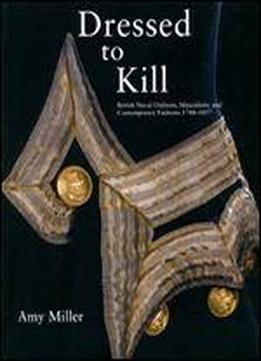
Dressed To Kill: British Naval Uniform, Masculinity And Contemporary Fashions 1748-1857
by Amy Miller /
2007 / English / PDF
153.8 MB Download
The uniform of the Royal Navy, the 'true blue' that was so firmly associated with it in 1828, when the passage above was written, was not by that time a tradition, certainly not one that stretched back to the days of England's victory over the Spanish Armada. Instead, it was only eighty years old. Regulated naval uniform had been worn only since 1748 before that the naval officer wore his own clothing, although there were certain occasions when royal livery was worn by specific officers. One of the earliest dates from 1604, when James I provided red and gold livery to six Principal Masters of the Navy.2 Their rich clothing was detailed in a royal warrant, being made from 'two yards of fine red cloth ... two yards of velvet ... two dozen buttons of silke and golde'3, the whole 'richlie imbrodered with Venice golde, silver, and silke, and with spangle of silver and silke1.4 Clearly such clothing would have had limited use, being suitable only for court attendance and ceremonial functions. It is telling that, in 1676, the Masters Attendant, as they had become known, petitioned to be paid a cash allowance in lieu of livery.5 In comparison with other nations, the Royal Navy was quite slow in adopting a uniform. The French navy was granted theirs during the second half of the seventeenth century, although Sweden and Spain got theirs in the late eighteenth century. While military uniform was not a particularly innovative concept, what is interesting is that the desire for it within the navy emerges during a period when a brilliance and correctness in dress was perceived as exercising a civilizing influence. As Joseph Baretti pointed out in 1760, 'People well dressed have in general a kind of respect for themselves.'6 As the navy had a chronic image problem during the course of the eighteenth century, when sailors were perceived as crude and coarse, it is likely that uniform was seen as one way of addressing this issue. The aim of this catalogue is to explore the relationship between uniform and contemporary fashions, which in turn not only allows for a greater understanding of the navy itself, but also of the complicated social messages encoded in its clothing. An examination of the amendments to uniform in conjunction with period literature, pamphlets and tracts gives a sense of the changing public perceptions of the Royal Navy during the period 1748-1857 and the role that uniform played in visually reinforcing these views. Male dress, particularly something so heavily regulated as uniform, illustrates the shifting standards of masculinity and provides insight into what British society in the eighteenth and nineteenth centuries valued as the 'ideal man'.











